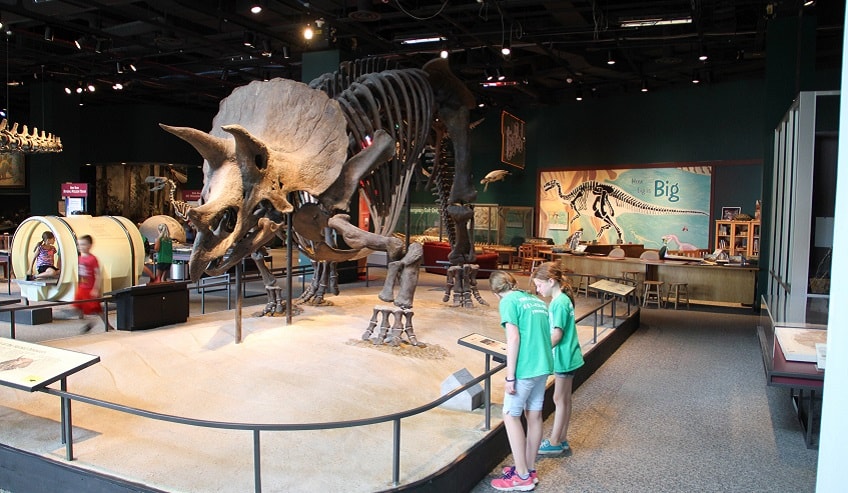
The Glue Talk Blog

The Science Museum of Minnesota was founded in 1907 and exists to inspire learning, inform policy, and improve lives. Specifically, the dinosaur and fossil collections house one of only four real Triceratops on display in the world and the largest complete specimen on display.
But the famed Triceratops display might not have been possible without the help of H.B. Fuller scientists over 40 years ago.
An Enormous Undertaking
When the science museum decided to begin the process of expansion in 1977, no one would have guessed that work on a new building across the street would affect the 4-ton skeleton. But after blasting started, museum staff noticed that the Triceratops began developing hairline cracks in the fossilized bone. Blasting immediately stopped, and the museum constructed a sling to cushion the skeleton from further damage.
Bruce Erickson, Curator of Paleontology at the museum, immediately set out to find a solution to seal the cracks, knowing that certain minerals in the fossilized bone would crystallize when exposed to the air and could eventually force the fragments apart.
He solicited the help of H.B. Fuller scientists to repair one of the museum’s most prized specimens.
A Delicate Process
H.B. Fuller chemist Dick Steinke was up for the task of recommending an adhesive that would fill the cracks and prevent crystal formation. He knew that the highly porous nature of the bone and plaster meant that the most acceptable system would be a 100 percent solid epoxy that would not shrink or expand with aging or temperature variation.
After testing many formulas in the lab that were compatible with the fossilized bone and plaster, he decided on FE 6084, a low viscosity epoxy that had good flow properties and would allow sufficient open time to remain fluid during the slow, precise application.
The most difficult task was to devise a method of injecting the adhesive into each of the delicate cracks. Steinke decided on a hypodermic needle, and spent long hours at the museum painstakingly applying the adhesive into the gaps.
Using Science to Further Science Education
Today, the museum’s horned reptile remains the best and most complete reconstruction of this ancient plant-eater. Had it not been for H.B. Fuller scientists, like Dick Steinke, the Triceratops, which roamed North America about 70 million years ago, might have been lost forever.
While repairing a dinosaur skeleton certainly is not an everyday occurrence for the scientists at H.B. Fuller, it is just one of the many examples of how our high-tech innovations are helping preserve scientific artifacts through unique collaboration and partnership opportunities.
It’s also an example of our passion for facilitating education for future generations. In addition to projects like the above, we also continuously fund exhibits and research, sponsor galleries, and are even supporting a hands-on space in 2019 where visitors can learn from local inventors, create their own inventions, and inspire an interest in STEM innovation.
"We have been amazed and pleased about the quality of the epoxy and how well it has held up over the years. Clearly, H.B. Fuller was the perfect partner to help with this tricky problem solving," said Rebecca Newberry, Conservator of the Collections at the Science Museum of Minnesota. At H.B. Fuller, we are excited to continue strengthening our relationship with the museum, and to work together toward our shared goals.
Learn more about the many ways we’re connecting what matters.
Blog Categories
Blog Categories
Archive
- 2024
- 2023
- 2022
-
2021
- January (3)
-
February (7)
- Celebrating Exceptional Service During COVID-19 Complications
- Cyanoacrylates: What They Are and What They Do
- Innovative two-shot bookbinding adhesive
- Make a Difference 2020
- Problem Solving: Paper Straws in Drinking Beverages
- Stronger straws sustainable future
- Substances of Interest in Disposable Absorbent Hygiene Products
- March (4)
- April (4)
- May (4)
- June (5)
- July (2)
- August (5)
- September (2)
- October (1)
- November (3)
- December (2)
-
2020
- January (4)
- February (2)
- March (3)
- April (4)
- May (3)
-
June (7)
- Community Support in the Era of Coronavirus
- HBFuller Employee Creates Face Shields with 3D Printer
- Improved Packaging Integrity and Greater Customer Satisfaction
- Liquid-Resistant Paper Straws
- What is a Sealant?
- What Is the Future of Commercial Disinfectants?
- Winning over consumers with e-commerce packaging solutions
-
July (6)
- Employees Take Action to be Part of Healing and Growth
- Gain a competitive advantage with packaging adhesive solutions
- HB Fuller Company Foundations Commitment to Communities
- Packaging Solutions for the South African Agriculture Market
- Supporting Organizations That Provide STEM Education for Youth
- Where Does Sustainability Stand Amid COVID-19
- August (3)
- September (2)
- October (4)
- November (2)
- December (4)
